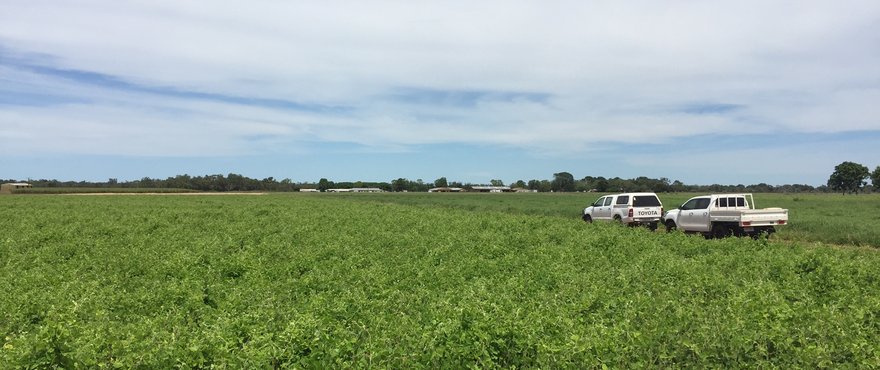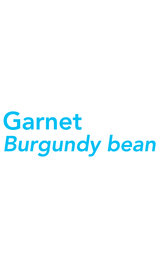Download a copy of the Garnet Burgundy Bean factsheet.
Garnet, a tropical legume from the Macroptilium family, is a high yielding, highly palatable legume. Suitable as a monoculture or in mixes, this species is well adapted to both grazing and high quality hay production. The non-bloating characteristic of Garnet makes it an ideal choice for any animal production system. Garnet burgundy bean is deep rooted, allowing the variety to be drought tolerant. Being a later maturing variety, Garnet is well suited to longer growing seasons, higher rainfall, coastal regions and hay making. The improved seed yielding ability of this variety allows Garnet to regenerate well from both new seedlings and existing plants, greatly improving persistence. Garnet burgundy bean is closely related to Siratro but is more cold tolerant than this species and is commonly referred to as the sub-tropical equivalent of the more tropical adapted butterfly pea.
Agronomy and management
Garnet burgundy bean is well suited to tropical, sub-tropical and warmer coastal temperate regions. Garnet is suitable to a wide range of soil types from sandy loams to heavy clays, acid to alkaline. Best adapted to moderately heavy to heavy textured soils but will not tolerate prolonged waterlogging.
It has been selected for its tolerance of the cooler growing regions, being capable of growing at lower temperatures than most other tropical and sub-tropical legumes, giving it a longer growing season. It will grow on into the late autumn, providing more palatable feed. Garnet burgundy bean exhibits early season growth coming out of winter with exceptional ‘bounce back’ upon the commencement of warmer weather.
Establishment
The larger seed size of Garnet assists with easy, rapid establishment. Seed should be planted when soil temperature exceeds 17 degrees Celsius. Seed can be drilled or broadcast and being a small seed, should be planted ideally at 5mm and no more than 1cm deep. Seed to soil contact is important and results can be varied with surface sown seed. The use of press wheels or, on non-hard setting soils rolling after sowing, will greatly improve germination and establishment by providing ample seed to soil contact. Follow up rain post planting is ideal. Care should be taken not to plant in the hottest summer weather without adequate moisture – the seed must maintain close contact with wet soil for about 3−4 days to establish a seedling. The use of AgriCote coated seed will greatly improve the establishment success of Garnet burgundy bean.
Fertiliser / nutrition
The use of AgriCote coated seed ensures essential macro and micronutrients are immediately available to the seedling. Responds strongly to phosphorus, zinc and sulfur. Starter fertiliser (P and Zn) is recommended at sowing, banded away from the seed. Application of 10−20Kg/Ha P (e.g. 100−200Kg/Ha of superphosphate) improves performance on old cropping soils. Molybdenum may also be necessary in some situations. A maintenance fertiliser program is recommended to replace nutrient removed by hay cutting over time. Inoculating seed with a compatible rhizobia inoculant is vital for nitrogen fixation to facilitate plant requirements of nitrogen. The use of a soil test will form the foundation of a suitable fertiliser program.
Growth habit
Garnet burgundy bean is an erect and trailing pubescent herbaceous perennial. It has a low growing crown and continually produce new shoots. The twining, ‘vine like’ nature of Garnet make it ideal for tropical mixes with grasses. Garnet has an indeterminate flowering habit, usually 21−28 days later than Presto burgundy bean, continuing to flower and set seed throughout the growing season.
Persistence
Garnet is a drought hardy, persistent perennial due to its robust root system. Garnet has the ability to continually produce new shoots following grazing/cutting, regenerating from existing plants. Best regrowth is obtained when the crop is fully established due to its capacity to store food reserves in the roots.
Compatibility (with other species)
Garnet burgundy bean performs extremely well in combination with grasses, including Rhodes grass, Buffels, Digitaria, Panic, Guinea Grass, Brachiaria, Setaria, Bluegrasses and Millet. Combines well with other pasture legumes such as Siratro, Butterfly Pea, Stylo, Glycine, Lucerne, Clover and Medic.
Uses
Suitable for hay production and/or grazing. It is also suited to weed or erosion control. Garnet burgundy bean offers an alternative to lucerne, butterfly pea and summer forage legumes such as lab lab as a pasture or for fodder/forage production.
Toxicity
Garnet burgundy bean does not cause bloat. No record of toxicity in any livestock species. Ideal legume species for horse pastures.
Management
The success of a pasture will depend on grazing management in the first season. Garnet burgundy bean is a short-lived perennial, relying on seedling recruitment for ongoing stand persistence beyond 2−3 years, such that older stands will become a mix of older crowns and newer seedlings. This variety will pod and seed readily, with pods that shatter and disperse seed up to several metres away from the parent plant. Due to its high palatability, management intervention may be required to ensure that the Garnet burgundy bean has periodic opportunities to set seed, particularly in younger stands. Care must be taken in early developing stands to allow a hard seed bank to develop.
Recommended Sowing Rate (AgriCote coated seed):
Pasture mix (over-sow): 2−5Kg/Ha
Stand alone dryland: 3−6Kg/Ha
Irrigated: 6−10Kg/Ha
Plant Breeders Rights (PBR): This variety is registered under Plant Breeders Rights (PBR) in Australia. Unauthorised commercial propagation or any sale, conditioning, export, import or stocking of propagating material is an infringement under the Plant Breeders Rights Act (1994). Any breach of this legislation will leave the grower liable for prosecution.
Disclaimer: The information presented in this brochure is from official and other sources and is considered to be reliable. It is provided in good faith and every care has been taken to ensure its accuracy. Barenbrug does not accept any responsibility for the consequences that may arise from the acceptance of recommendations or the suggestions made.



